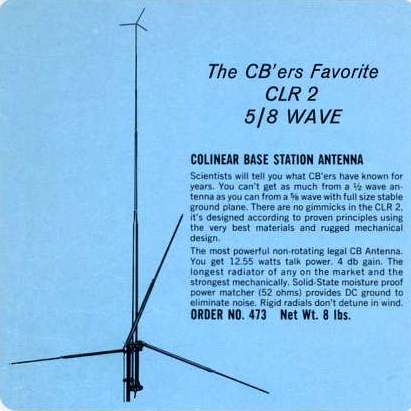

This is the Hy-Gain model CLR-2 5/8 wave omni-directional ground plane antenna. This is also virtually identical to the "Colinear" 5/8th wave antenna marketed by Radio Shack. This antenna sported a 19' 10" length radiator with 3 102" radials, as well as 3 small 8 inch top hat "radials" at the top of the antenna to proportedly reduce static build-up. This antenna had an advertised gain of 4 dbi, and was one of the most popular antennas in the local area in the 1970's. The Radio Shack version was more popular due to the number of Radio Shack retail stores in the area, which made it easy to plunk your cash ($34.95 in 1977) down on the table and walk out with the antenna in hand.
Despite its immense popularity and decent performance, this was not the antenna to run if you had any desire to run any power greater than about 200 watts. 5/8th wave antennas, by design, require an impedance matching device to convert the antenna's feedpoint impedance to 50 Ohms. In this antenna, that matching circuit consisted of a flat circular printed circuit board with the inductive helix etched into the board. It would not take very much power, and in fact one of our locals (Steve) actually burned one out with a Palomar Skipper 300 amplifier. The other downside to this design is that the matching circuit would detune if exposed to moisture, and it was very difficult to prevent rain water from entering the matching section. It was not unheard of for the SWR of one of these antennas to climb close to 3:1 during an especially heavy rain.
Another soft spot with the Radio Shack version of this antenna was its physical construction. The element sections were held together by simple sheet metal screws. No matter how well they were tightened, they would invariably start to loosen in the wind, which would then lead to fluctuations in the SWR. Eventually the screws would work their way completely out, and the antenna sections would slowly slide down inside each other and shorten, resulting in a sharp rise in SWR and a corresponding decrease in performance. I've recently seen some of these older relics in this condition. It's obvious that they're no longer being used, as the SWR would be sky high at this point. A few of the locals solved this problem by hack sawing an "X" into the top part of each section, and then clamping the sections together with a strong stainless steel hose clamp. And that's pretty much how the Hy-Gain version of this antenna was designed.